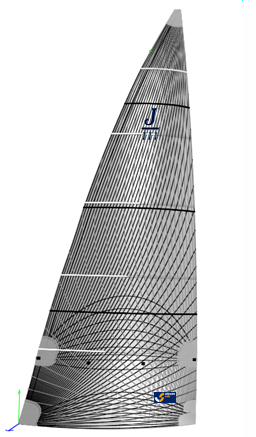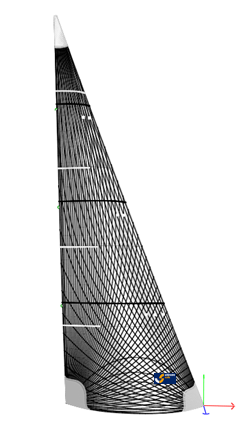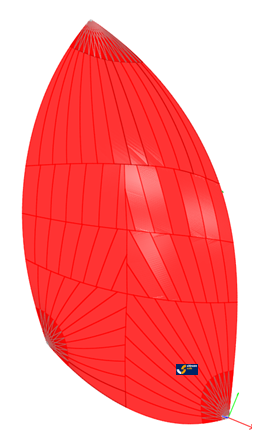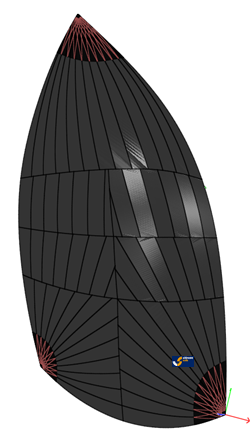J112 one design sails
“A huge shoutout to Ultimate Sails for their amazing service! It’s been awesome teaming up with Kevin to create these winning sails. The personal touch, careful development, and attention to detail have been outstanding, and the results really show it.
Our J112 sails fit perfectly and worked great right from the start with no tweaks needed.”
Duncan McDonald
Shmokin’ Joe
Construction Upwind Sails
Class sails are made using Carbon and Black Aramid fibres, which strike a nice balance between keeping their shape and delivering solid performance. To make them tougher, a technora X-ply scrim is added along with extra fibre passes on the leech.
Mainsail
The mainsail needs to be tough and adaptable enough to handle up to 35 knots without reefing. Thanks to the fairly stiff carbon mast, we can create a sail with less luff curve and more roach compared to similar-sized sails. The larger roach boosts performance across the board, offering better speed downwind and making it easier to depower the sail and keep rudder balance upwind. We’ve also recently rolled out new fibre layouts to maintain the sail’s aerodynamic shape across the full range of backstay tensions.
Class Mainsail
Construction type: Membrane Lightwave
Surface type: UV film (Taffeta option)
Fibre type: Carbon / Black Aramid
Fibre DPI: 14000
Wind range: 0 – 35 kts true
Standard Features
- Top full length batten
- Tapered leech battens
- Laminated batten pockets
- Sail bag
- Cunningham
- Vectran leech and foot lines
- Trim stripes
- Laminated patches
- Sail numbers
- Tell tales
- Velcro clew strop
- Class logo
- Race measurement
- Class reef

Headsails
When class racing, J112 Jibs are set on a furler, which can cause a performance issue known as the end plate effect. This happens when there’s a gap between the foot of the sail and the deck, letting air escape underneath and reducing aerodynamic efficiency. Many J111 headsails lack enough foot round, creating this gap and resulting in a less effective sail.
Ultimate Sails J112 Jibs are designed with enough foot round to keep air flowing over the sail consistently, boosting performance. Studies show that closing the gap between the sail’s foot and the deck can improve aerodynamic efficiency by 5–7%. The difference is noticeable, especially when accelerating out of a tack. Get into a tacking battle with someone using our latest design, and you’ll see who comes out ahead!
The Jibs’ vertical profile is carefully optimized to work efficiently across a wide wind speed range. We’ve tweaked the design to ensure maximum power at lower wind speeds while still allowing the sail to flatten with sheet and halyard tension for top-end performance.
We’ve also added new Fibre layouts with higher fibre content (DPI) to help the sails hold their shape in stronger winds. For the leech of the class Code 3 ORC jib, vertical battens provide reliable and cost-effective support for furled sails.
Class Jib Code 1
Construction type: Membrane Lightwave
Surface type: UV film
Fibre type: Carbon / Black Aramid
Fibre DPI: 10000
Wind range – 0 – 10 kts true
Standard Features
- Tapered leech battens
- Laminated batten pockets
- Double zip deck launch bag
- Vectran leech and foot lines
- Trim stripes
- Laminated patches
- Tell tales
- Race measurement
- Stanchion patches

Class Jib Code 2
Construction type: Membrane Lightwave
Surface type: UV film
Fibre type: Carbon / Black Aramid
Fibre DPI: 14000
Wind range – 6 – 20 kts true
Standard Features
- Tapered leech battens
- Laminated batten pockets
- Double zip deck launch bag
- Vectran leech and foot lines
- Trim stripes
- Laminated patches
- Tell tales
- Race measurement
- Stanchion patches

Class Jib Code 3 ORC
Construction type: Membrane Lightwave
Surface type: UV film
Fibre type: Black Aramid
Fibre DPI: 16000
Wind range – 18 – 25 kts true
Standard Features
- Vertical tapered leech battens
- Laminated batten pockets
- Double zip deck launch bag
- Vectran leech and foot lines
- Trim stripes
- Laminated patches
- Tell tales
- Race measurement
- Stanchion patches

Asymmetric
Ultimate Sails J112 Class Asymmetrics dominated in 2011, and we’ve made further tweaks to keep our customers leading the pack in 2012. With class rules limiting the J112 to two downwind sails, we’ve designed a Code 2 and Code 4 that work perfectly with the polars we developed last season. In some cases, our customers were hitting speeds 50% faster than the designers’ polars (average downwind speed of 18.51 knots!), thanks to a stable luff that rolls smoothly to windward. This lets the helm push the boat hard downwind.
The sail’s stepped construction, featuring 0.9oz nylon in the high-load luff area, and the maximum twist in the top leech boost acceleration and help the sail plane early—making it an all-around top performer.
Class Asymmetric Code 2
Construction type: Tri optimal
Material: 0.75 / 0.9oz Nylon
Apparent wind angle range: 60 – 140 deg
Apparent wind speed range: 0 – 13 kts
Standard Features
- Sail numbers
- Deck launch bag
- Vectran Luff line
- Race measurement

Class Asymmetric Code 4
Construction type: Tri optimal
Material: 0.9oz / 1.5oz Nylon
Apparent wind angle range: 80 – 140 deg
Apparent wind speed range: 10 – 20 kts
Standard Features
- Sail numbers
- Deck launch bag
- Vectran Luff line
- Trim stripes
- Race measurement
- Tack prodder
- Take down patches

